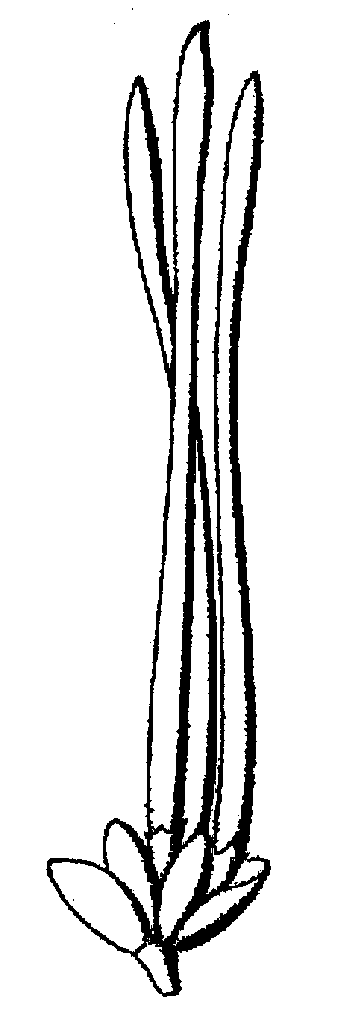
Distribution Map

Description (Barlow 1992)
Dicymanthes tetrapetala Danser, Blurnea 3 (1940) 399. - Amyema tetrapetala (Danser) Barlow, Austral. J. Bot. 22 (1974) 595. - Type: Womersley NGF 19321 (neo CANB 153818, see below; isoneo L), New Guinea, Morobe, Wagau, 4000 ft (1220 m), 13.vi.1964.
For description see Barlow, Austral. J. Bot. 22 (1974) 595. The
species was placed by Danser in his genus Dicymanthes, in
which the inflorescence is capitate, of two sessile triads on
a shon peduncle. The species probably is not closely related to
other species ascribed to that genus, and probably has no very
close relatives. See discussion on Dicymanthes under Amyema
above. Within the Dicymanthes group it can be identified
by its enlarged bracts, forming an involucre which considerably
exceeds the ovaries, and by its 4-merous flowers. The corolla
colour has been recorded as various shades of red in the lower
pan, grading to orange or yellow above.
Amyema tetrapetaIa is endemic to New Guinea, being recorded from a few localities in the Morobe District (fig. 16; 5 collections seen), in highlands at elevations from 1200 to 2200 m. The species occurs in primary rain forest, but hosts are unknown.
Dicymanthes tetrapetala was based on Mayr 819 (B,
no longer extant), New Guinea, Saruwaged Mts, Ogeramnang, 1500
m, 22.iii.1929. No isotypes have been located. The specimen Womersley
NGF 19321 (CANB) bears a number of mature inflorescences,
agrees closely with Danser's description, and is duplicated in
L. It is accordingly selected as neotype.
Description (Barlow 1974)
Amyema tetrapetalum (Dans.) Barlow, comb. nov.
Dicymanthes tetrapetala Dans. Blumea 3: 399, illus. Fig. 1, d (1940). Type-New Guinea, Saruwaged Mts., Ogeramnang, 1500 m alt., Mayr 819, 22.iii. 1929 (B, not seen, probably destroyed).
Young parts, inflorescence, bracts and calyx shortly brown-tomentose. Stems terete, branched at nearly every node; internodes long. Leaves opposite; petiole c. 5 mm long; lamina broad lanceolate, 10-1.5-(20) by 4-6-(8) cm, gradually attenuate at the base, recurved at the margin, acuminate and acute at the apex; venation pennate with the midrib and lateral veins distinct on both sides. Inflorescences several at the nodes, each consisting of a head composed of two opposite triads with all flowers sessile; peduncle 3-6 mm long; central bracts erect, narrow lanceolate, acute, 6 by 2.5 mm; lateral bracts c. 6 by 1.5 mm; all bracts often of irregular shape at the apex.
Calyx cylindrical, 3 mm long; limb irregular, 0.5 mm long. Corolla in the mature bud very slender, 35-42 mm long, quadrangular, 4-merous. Anthers acute, 3-4 mm long; free parts of the filaments 2.5 times as long. Fruit not seen.
Occurrence. New Guinea, from the Saruwaged and Herzog Ranges and Bulolo area (Fig. 6), 1200 to 1800 m altitude.
Specimens Examined.
EASTERN NEW GUINEA: Wagau, Morobe Dist., 1360 m alt., Millar NGF 23385, 11.vi.1964 (AD; L; LAE); Wagau, 1200m alt., Womersley NGF 19321, 13.vi.1964 (CANB; L); Wagau, 1430 m alt., Barlow 936, 7.ii.1965 (AD; L; LAE); Nawata Banda, 5 miles SW. of Bulolo, Morobe Dist., Streimann and Farasulu NGF 47786 (L).
The genus Dicymanthes as delimited by Danser includes D. tetrapetala and 12 other species occurring in the Philippines, Celebes, Moluccas, Java and the Lesser Sunda Islands. The inflorescence is a head formed from two sessile triads, and is undoubtedly a simple reduction from the common Amyema inflorescence of a pendunculate umbel of triads (cf. Barlow 1966, Fig. 5, m). Closely similar inflorescences occur in Diplatia, Distrianthes and in Amyemna maidenii, which is so similar in inflorescence structure to the species of Dicymanthes that it would have to be placed in Dicymanthes if that genus were maintained. The reduction of the inflorescence must have occurred independently several times, and can have little value as a generic character except where associated with other characters of the inflorescence (cf. Barlow 1962, p. 60).
While the genus Dicymanthes as delimited by Danser is not
accepted here, the status of D. tetrapetala is difficult
to assess. As noted by Danser (1940), D. tetrapetala differs
from the other species of that genus in the greater development
of involucral bracts and in the 4-merous flowers, as well as its
remote geographical occurrence. These characters (especially the
first) give the species a very distinct position, whether one
accepts the genus Dicymanthes or includes it in the genus
Amyema. I am reluctant, however, to establish yet another
genus which would represent no more than an extreme of inflorescence
development in Amyema.
Illustrations

Amyema tetrapetalum (as Dicymanthes tetrapetala). Inflorescence with one triad of flowers in bud present, the other three flowers taken away. From Danser (1940)
Photographs
Amyema tetrapetala
updated 18 January 2007